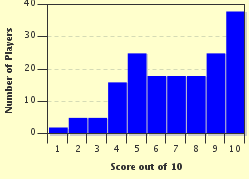Quiz Answer Key and Fun Facts
1. One of the most important stars in our sky, historically, is also the one that acts as the baseline for the scale of stellar magnitude. The principal star of the constellation Lyra and one corner of the Summer Triangle, what is its name?
2. Also known as Alpha Ursae Minoris, what is the name of this variable magnitude star that also serves as the North Star?
3. This star's magnitude fluctuates between 0.2 and 1.2, and despite its designation Alpha Orionis, it is actually the second brightest star in the constellation Orion. By what name (you don't have to say it three times) is it known?
4. The brightest star in our night sky has a magnitude of -1.46. Kidding aside, it's twice as bright as the next brightest star. What is its name?
5. In the constellation Gemini, two stars sit side by side (the heads of the twins) with the names Castor and Pollux. Which is the brighter of the two, with an apparent magnitude of 1.15?
6. With an apparent magnitude of -0.72, this star ranks second on the list of brightest stars in the night sky. What is the name of this star, found in the southern hemisphere constellation Carina?
7. Another point of the Summer Triangle, Deneb is the brightest star in the constellation Cygnus.
8. Of the three brightest stars in Orion's Belt (Alnitak, Alnilam and Mintaka), how many of them have a magnitude of greater than 2.00 (closer to zero)?
9. Proxima Centauri, the closest star to us (exluding the sun), is easily visible to the naked eye.
10. It's not really a star, despite its nickname 'The Evening Star', but after the sun and the moon, it is the brightest object in the night sky with an apparent magnitude of -4.6. Which planet is it, seen above our moon in this photo?
Source: Author
reedy
This quiz was reviewed by FunTrivia editor
WesleyCrusher before going online.
Any errors found in FunTrivia content are routinely corrected through our feedback system.

